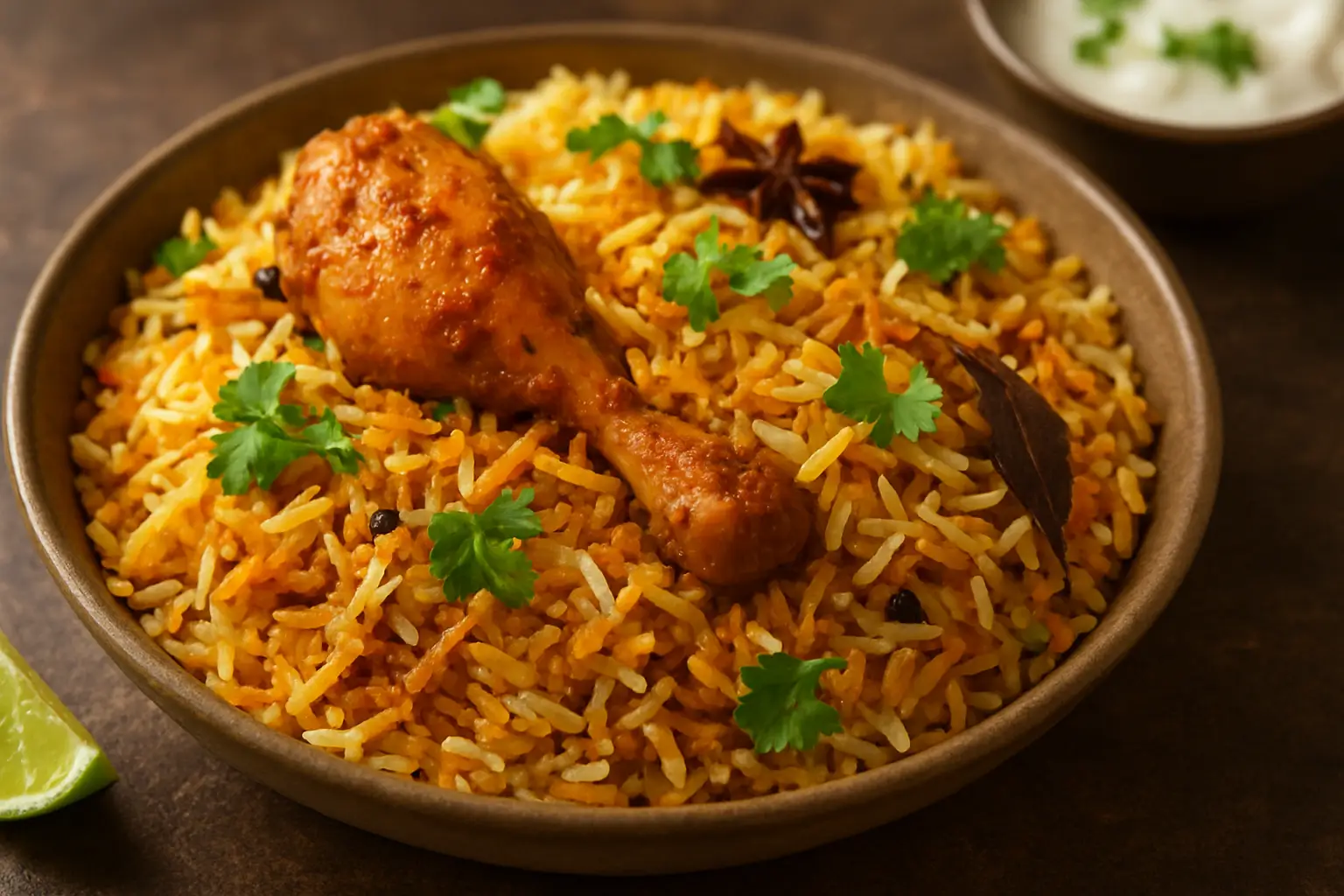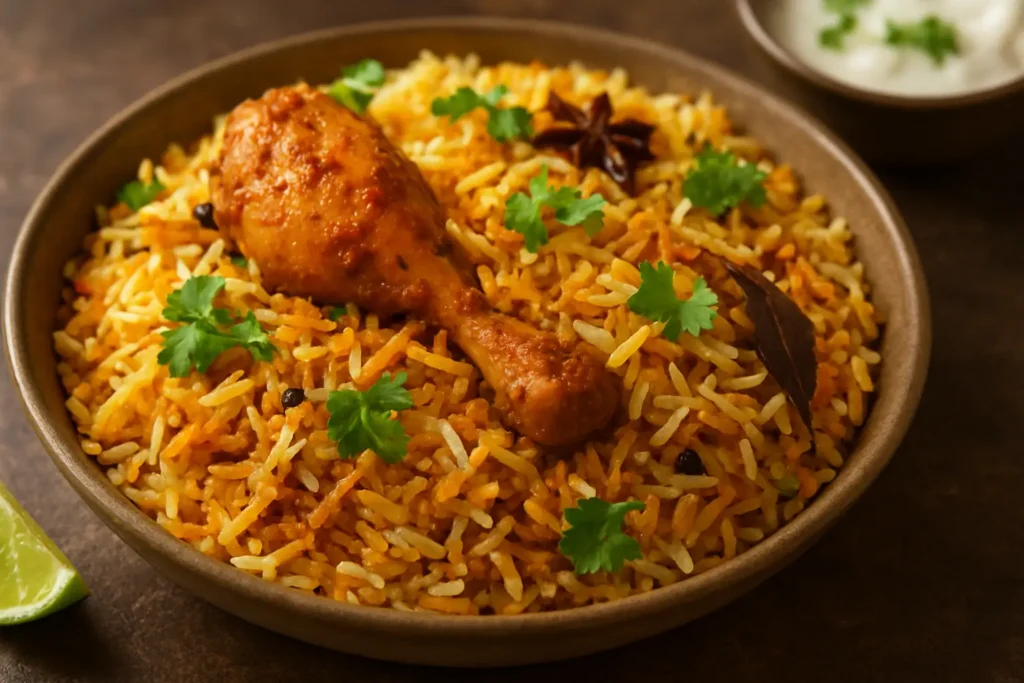
What is Chicken Biryani?
Chicken Biryani is a famous South Asian rice dish that brings together long-grain basmati rice, soft chicken pieces, and a mix of fragrant spices. The rice and chicken are cooked in layers, which gives the dish its rich taste and beautiful aroma.
Every bite is flavorful, warm, and satisfying, making it one of the most loved meals across the world. Even though it looks like a restaurant-style dish, the truth is that you can easily prepare it at home with the right steps and simple ingredients
Table of Contents
Why This Chicken Biryani is Special
This Chicken Biryani recipe is special because it brings the right balance of spices, rice, and chicken in every layer. What makes it different from regular biryani is the use of fresh herbs, saffron milk, and the slow-cooking dum method, which locks in deep flavors.
The soft chicken blends beautifully with the fluffy, fragrant rice, while golden fried onions and a touch of raisins add a light sweetness. Every bite feels rich, warm, and full of taste, making it a dish people remember and love.
Ingredients for Chicken Biryani
Making the perfect Chicken Biryani starts with choosing the right ingredients. Fresh spices, good quality rice, and tender chicken play a key role in building the deep flavor that this dish is known for. Below is a clear list of what you will need, along with simple tips and substitutions to help you get the best results every time.
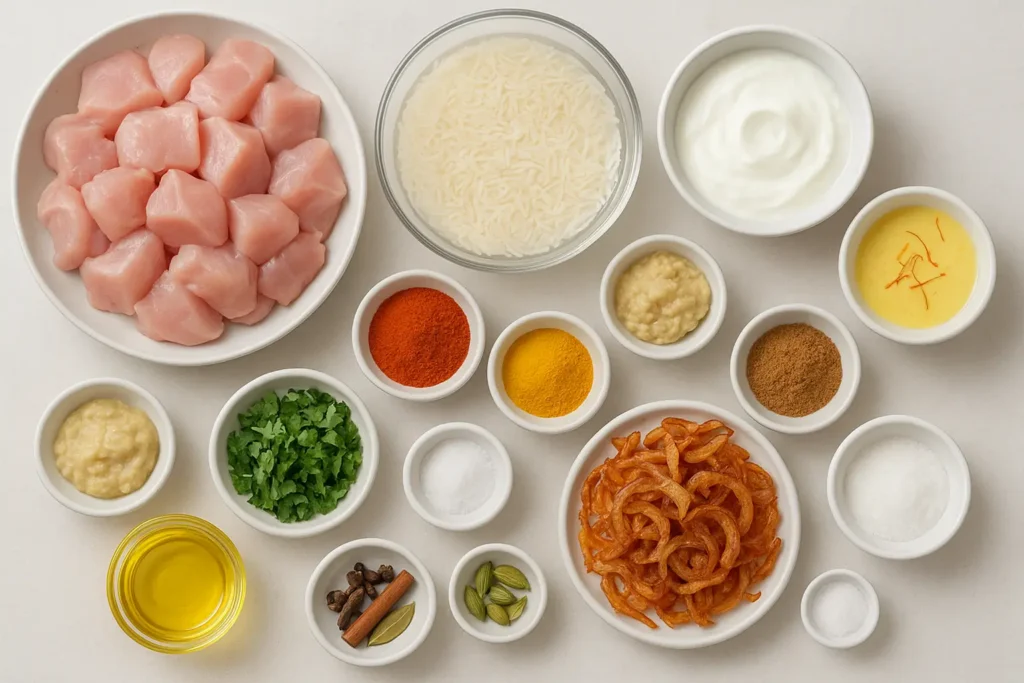
Key Ingredients
- 1 kg chicken, cut into medium pieces for even cooking
- 2 cups basmati rice, soaked in water for 30 minutes to get fluffy, separate grains
- 1 cup yogurt, which keeps the chicken soft and adds tangy flavor
- 2 tablespoons ginger-garlic paste, for depth and aroma
- 2 teaspoons red chili powder, for gentle heat and color
- 1 teaspoon turmeric powder, which gives a warm golden color
- 1 teaspoon garam masala, to bring all the spices together
- 2 large onions, thinly sliced and fried until golden for sweetness and crunch
- Whole spices: 2–3 cloves, 2–3 cardamom pods, 1 cinnamon stick, 1 bay leaf
- Salt, to taste
- 2 tablespoons ghee or oil, for richness and aroma
- Fresh coriander and mint leaves, chopped, for freshness
- Saffron soaked in 2 tablespoons warm milk, for flavor and natural color
Substitutions & Tips for Best Quality
- If you want faster cooking, use boneless chicken, but bone-in pieces give deeper flavor.
- Replace ghee with oil if you prefer a lighter version, though ghee adds a rich taste.
- If saffron is not available, add a small pinch of turmeric for color, though the aroma will be milder.
- Always soak the rice before cooking. This simple step ensures the grains stay long, fluffy, and separate.
How to Make Chicken Biryani (Step-by-Step)
Making Chicken Biryani may look complex, but when you break it into steps, it becomes easy to follow. By preparing the chicken, rice, and spices correctly, you can recreate that restaurant-style flavor at home. Follow these steps for the best results:
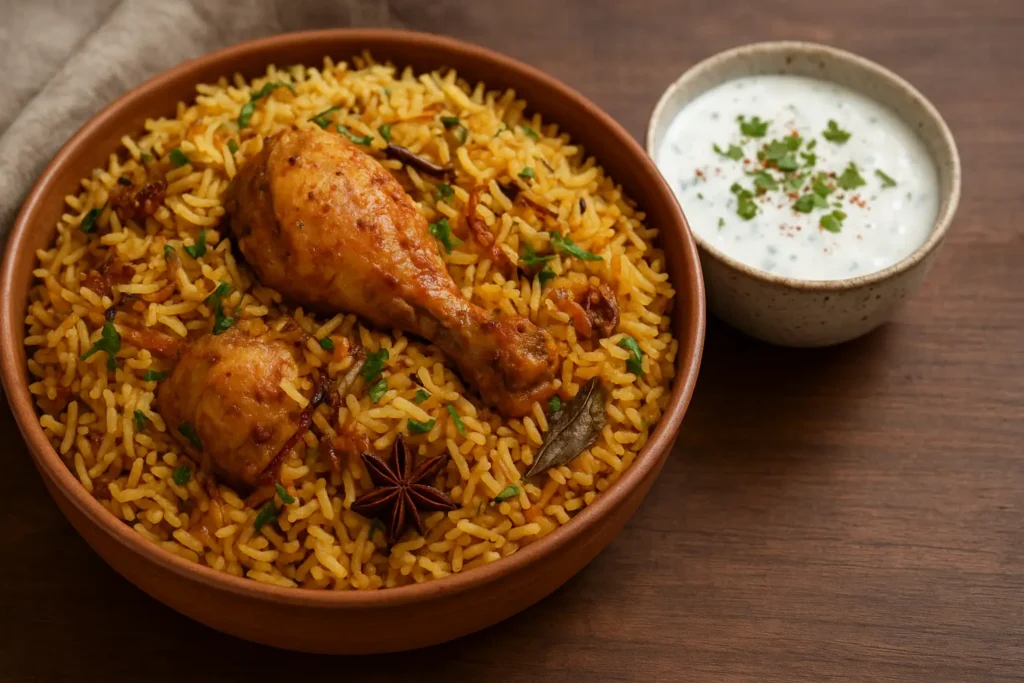
Step 1: Preparation
- In a large bowl, mix the chicken pieces with yogurt, ginger-garlic paste, turmeric, red chili powder, garam masala, salt, and a little lemon juice.
- Cover and let it marinate for at least 1 hour. For the richest taste, keep it overnight in the fridge so the flavors soak deep into the chicken.
- Rinse and soak the basmati rice in water for 30 minutes. This ensures the grains cook fluffy and separate.
- Slice the onions thinly and fry them until they turn golden brown. These fried onions will be used for both layering and garnish.
Step 2: Cooking Process
- In a large pot, boil water with cloves, cardamom, cinnamon, bay leaf, and a pinch of salt. Add the soaked rice and cook until it is about 70% done. Drain the water and set the rice aside.
- Heat the ghee in a heavy-bottomed pan and cook the marinated chicken until it is about 80% cooked.
- In the same heavy pot, start layering:
- Spread half of the rice at the bottom.
- Add the chicken pieces on top.
- Sprinkle biryani masala, saffron milk, chopped herbs, and some fried onions.
- Layer the remaining rice and top with the rest of the fried onions.
- Cover the pot with a tight lid and cook on low heat (dum method) for 20–25 minutes. This slow cooking allows the rice and chicken to absorb all the flavors.
Step 3: Serving & Finishing
- Once done, gently fluff the biryani with a fork to mix the layers without breaking the rice.
- Garnish with fresh coriander, mint leaves, and optional fried cashews or raisins for a festive touch.
- Serve hot with a side of raita, fresh salad, or a simple squeeze of lemon juice for added freshness.
Expert Tips to Make Chicken Biryani Perfect
Even though Chicken Biryani is a traditional recipe, small details make a big difference in the final taste. By following these expert tips, you can ensure your biryani turns out flavorful, aromatic, and restaurant-style every time.
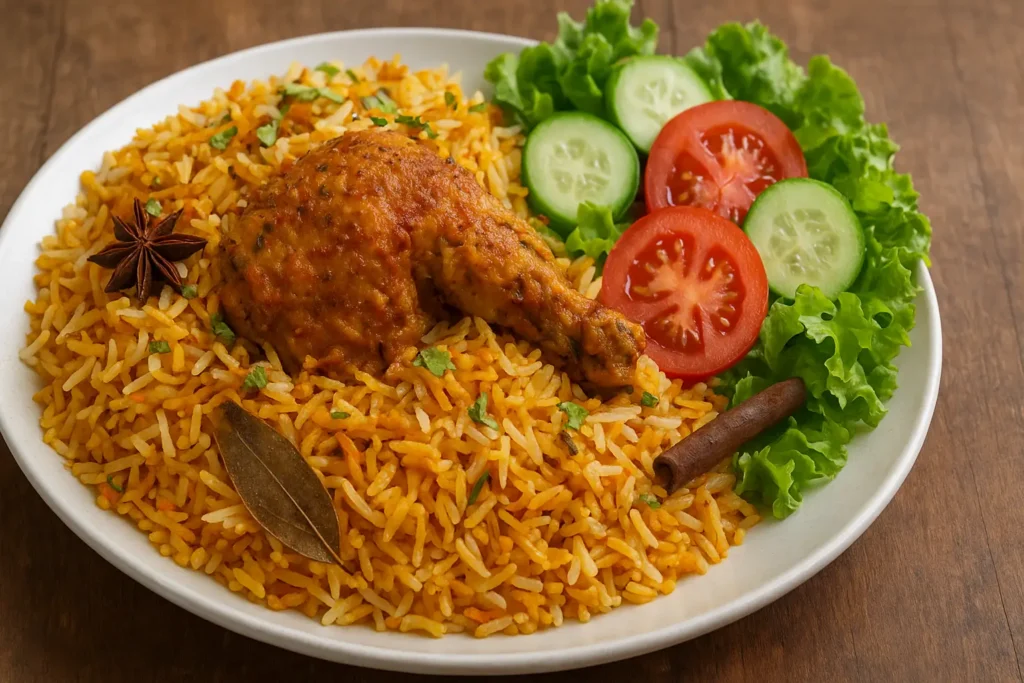
- Choose the right rice: Always use good-quality basmati rice. Its long, slender grains stay separate after cooking, giving biryani its classic look and texture.
- Marinate the chicken well: Proper marination with yogurt and spices makes the chicken soft and juicy. For the best results, let it rest for at least 1 hour or even overnight.
- Cook rice carefully: Do not cook the rice fully before layering. Cooking it only 70% done helps it finish cooking during the dum process, ensuring fluffy grains without turning mushy.
- Master the dum method: Slow cooking on low heat is the secret to authentic biryani. It allows all the flavors to blend together while preventing the bottom from burning.
- Add natural aroma: A touch of saffron milk or a few drops of rose water at the end gives the dish its signature fragrance and makes it feel extra special.
With these simple but powerful tips, your Chicken Biryani will taste rich, aromatic, and perfect every single time.
Variations of Chicken Biryani You Can Try
One of the best things about Chicken Biryani is that it is not limited to just one style. Across South Asia and beyond, different regions add their own twist to the recipe, creating unique versions with distinct flavors. Here are some popular types you can try at home:
- Hyderabadi Chicken Biryani – This famous dum-style biryani uses yogurt-marinated chicken, layered with fragrant rice, and cooked slowly. The slow cooking allows the spices and chicken juices to blend deeply, giving it a rich and bold flavor.
- Kolkata Chicken Biryani – Known for its mild spices, this version is lighter than others and includes potatoes as a special addition. A touch of rose water is also used, which gives it a delicate fragrance.
- Quick Chicken Biryani – If you are short on time, this one-pot version is the perfect choice. It uses ready-made biryani masala, which cuts down cooking time while still giving you a satisfying taste.
- Spicy Chicken Biryani – For those who love heat, this variation uses extra green chilies or chili powder. It delivers a fiery kick while still keeping the authentic biryani taste intact.
These variations show how flexible Chicken Biryani can be. You can adjust spices, cooking style, or ingredients based on your taste and still enjoy a dish that feels authentic and comforting.
What to Serve with Chicken Biryani?
A plate of Chicken Biryani is rich and flavorful on its own, but the right side dishes make the meal even more enjoyable. Traditional accompaniments bring freshness, balance the spices, and enhance the overall dining experience. Here are some delicious options to serve with biryani:
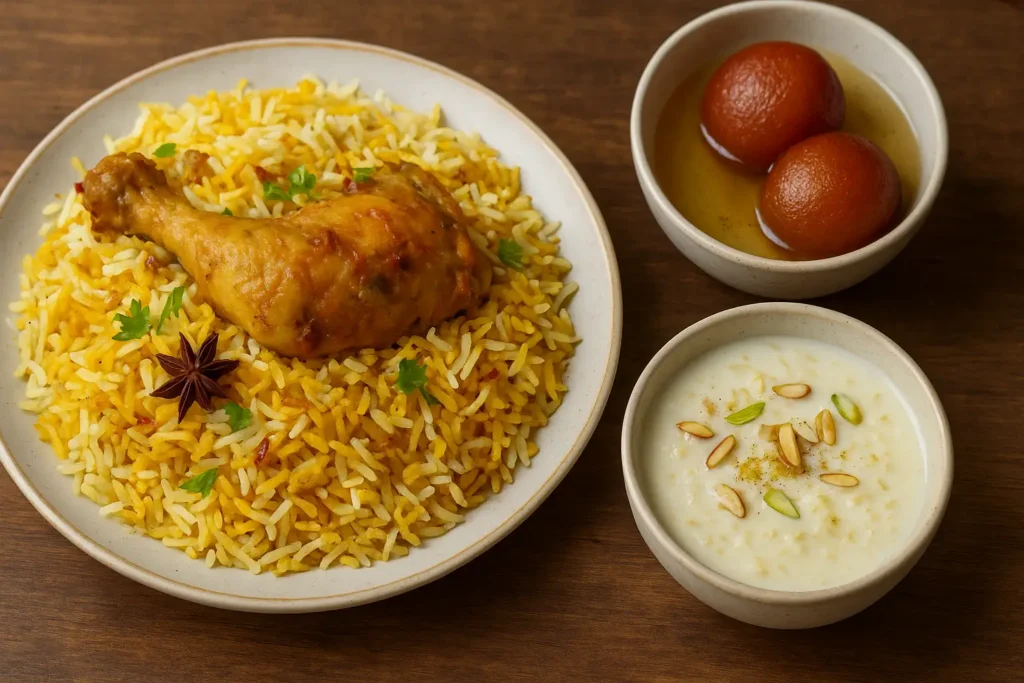
- Cool cucumber or onion raita: A bowl of chilled raita made with yogurt and fresh cucumber or onions is the most popular side. It cools down the heat of the spices and adds a creamy, refreshing touch.
- Boiled eggs for extra richness: Many people love to serve hard-boiled eggs with biryani. The eggs not only make the meal more filling but also pair beautifully with the spiced rice.
- Fresh salad or pickle for crunch: A simple salad of sliced onions, cucumbers, or tomatoes adds freshness, while a tangy pickle brings a burst of bold flavor that cuts through the richness.
- Lemon wedges to enhance aroma: A squeeze of fresh lemon juice just before eating brightens the dish and lifts the fragrance of the spices.
By adding these sides, your Chicken Biryani becomes a complete meal that feels satisfying, balanced, and restaurant-style right at home.
Storage & Reheating Instructions
If you have leftover Chicken Biryani, storing it the right way will keep it fresh and flavorful. Since biryani is a layered dish, it needs proper care to maintain its taste and texture after cooking. Follow these simple tips:
- Storage: Place the leftover biryani in a clean, airtight container and store it in the refrigerator. It will stay fresh for up to 2 days. Make sure the container is sealed well to prevent the rice from drying out and to lock in the aroma.
- Reheating on the stovetop: Transfer the biryani to a heavy pan, sprinkle a few drops of water, cover with a lid, and warm it gently on low heat. This method helps the rice stay soft and prevents burning.
- Reheating in the microwave: Place the biryani in a microwave-safe bowl, cover it lightly, and heat it in short intervals. Adding a spoon of water before reheating helps keep the grains moist.
- Avoid multiple reheats: Try to reheat only the portion you plan to eat. Reheating the same biryani again and again can reduce its flavor and make the rice dry.
By storing and reheating properly, your Chicken Biryani will taste almost as good as when it was freshly cooked.
Health & Nutrition Benefits
While Chicken Biryani is known for its rich taste and festive appeal, it also offers several nutritional benefits when made with fresh, quality ingredients. Here are some of the main health advantages:
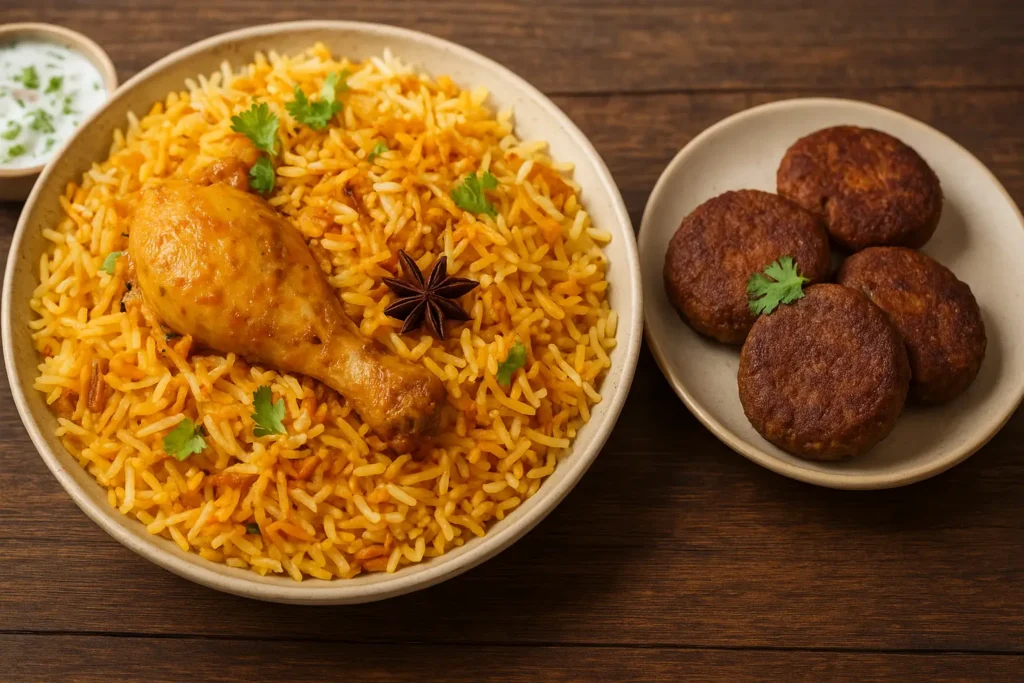
- Lean protein from chicken: Chicken is a great source of lean protein, which helps in building muscles, repairing tissues, and keeping you full for longer. Using skinless chicken makes the dish lighter and healthier.
- Digestive support from spices: Traditional biryani spices such as turmeric, cloves, cardamom, and cinnamon are not only flavorful but also aid digestion and improve gut health. Turmeric, in particular, has anti-inflammatory properties.
- Energy from basmati rice: Basmati rice provides slow-release carbohydrates, which means it gives steady energy over time without sudden spikes in blood sugar. This makes biryani more filling and satisfying.
- Antioxidants from herbs: Fresh mint and coriander leaves add a refreshing taste and are rich in antioxidants that support immunity and overall wellness.
- Balanced nutrition: When paired with raita, salad, or boiled eggs, biryani becomes a wholesome meal that includes protein, carbs, and healthy fats all in one plate.
By combining flavor with nutrition, Chicken Biryani proves that a traditional dish can be both delicious and beneficial for health when cooked with care.
FAQs about Chicken Biryani
Many home cooks have questions when preparing Chicken Biryani, especially for the first time. Here are some of the most common queries with simple, clear answers:
Q1: Can I make biryani without yogurt?
Yes, you can. While yogurt adds tenderness and a mild tangy flavor, you can replace it with a mix of lemon juice and spices to soften the chicken. Some people also add a little cream or coconut milk for richness.
Q2: How long does it take to cook biryani?
On average, making biryani takes about 1.5 hours, including marination, cooking the rice, layering, and finishing with the dum method. If you marinate the chicken overnight, the cooking process becomes quicker the next day.
Q3: Can I use frozen chicken?
Yes, frozen chicken works fine, but it should be thawed completely before marination. This ensures the spices and yogurt coat the chicken properly, giving it full flavor.
Q4: Can I make a vegetarian version?
Absolutely. You can replace the chicken with paneer, tofu, or mixed vegetables like potatoes, carrots, beans, and peas. The same layering and dum method will give you a flavorful vegetarian biryani.
Q5: Is saffron necessary?
Saffron is not essential, but it does add a beautiful golden color and authentic aroma. If you do not have saffron, you can use a small pinch of turmeric or even food-grade orange coloring, though the fragrance will be different.
Common Mistakes to Avoid
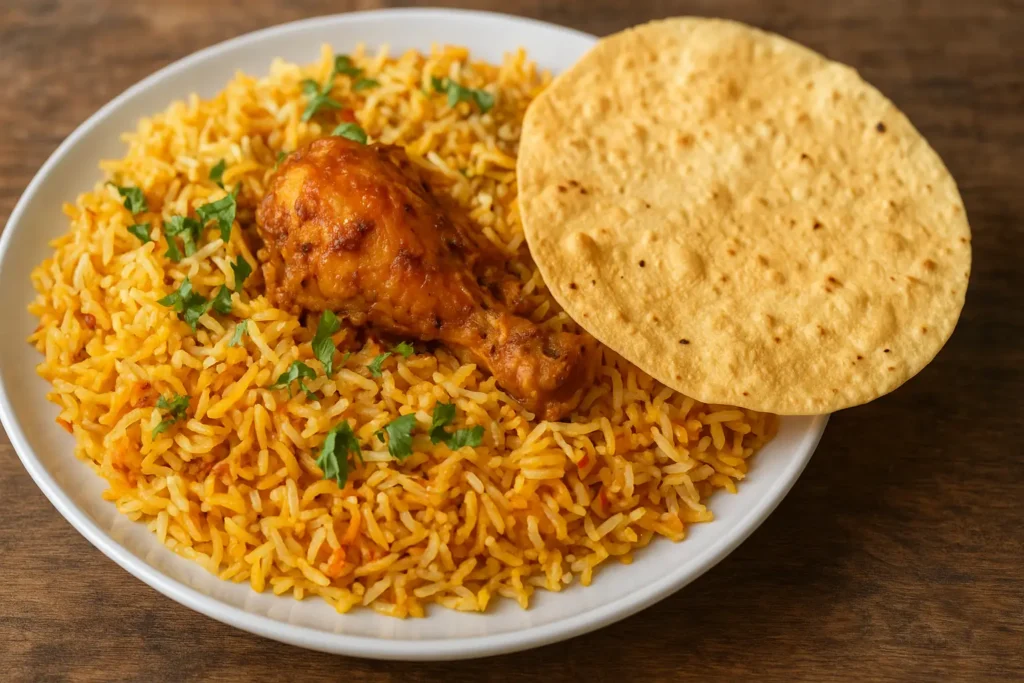
Even though Chicken Biryani is a well-loved dish, a few small mistakes can affect its taste, aroma, or texture. By keeping these points in mind, you can avoid problems and make sure your biryani turns out perfect every time.
- Overcooking rice before layering: The rice should only be about 70% cooked before layering. If it is fully cooked at this stage, it will become mushy during the dum process. Always check the grains and stop cooking while they still have a slight bite.
- Using too much water in rice: Extra water makes the rice sticky and clumped together. Measure the water carefully and drain the rice once it reaches the right doneness to keep the grains long and separate.
- Skipping marination: Marination is key for juicy, flavorful chicken. If you skip it, the chicken may taste bland and dry. Allow at least 1 hour of marination, or ideally overnight for the best results.
- Cooking on high heat during dum: The dum method requires low heat so the flavors blend slowly. High heat can burn the bottom layer while leaving the top dry. Always cook on the lowest flame with a tight lid.
- Forgetting herbs and saffron: Fresh herbs like mint and coriander, along with saffron milk, give biryani its signature aroma and color. Skipping them may leave the dish less vibrant and flavorful.
By avoiding these common mistakes, your Chicken Biryani will come out fragrant, balanced, and just like the restaurant-style version everyone loves.
Bonus Chef Tip
- Add Kewra or Rose Water: During the final dum cooking, sprinkle just 2 to 3 drops of kewra water or rose water on top of the rice.
- Enhances Aroma: This step adds a gentle floral fragrance that blends beautifully with the spices.
- Restaurant-Style Finish: It is the same trick many chefs use in restaurants to give their biryani a signature aroma.
- Use Sparingly: Avoid adding too much, as strong floral water can overpower the natural flavors.
- Impress Your Guests: This small step makes your Chicken Biryani smell and taste like a festive, royal dish.
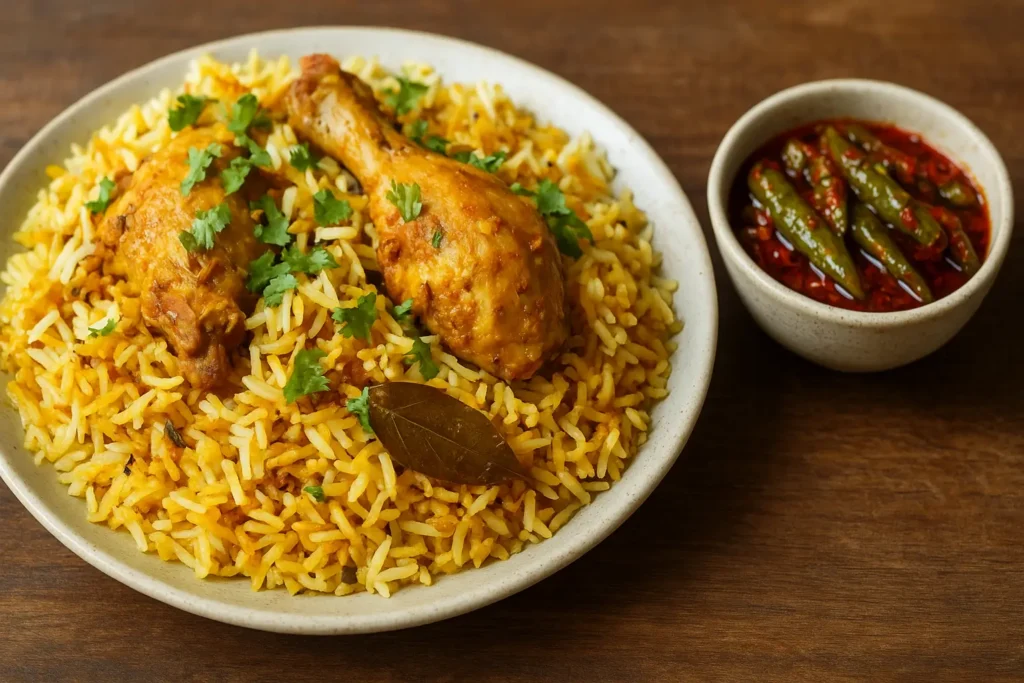
Related Recipes
- Chicken Korma Recipe: A creamy, flavorful curry made with yogurt, nuts, and aromatic spices. Perfect for pairing with naan or steamed rice.
- Mutton Biryani Recipe: A rich and royal biryani made with tender mutton, basmati rice, and fragrant whole spices. Great for festive meals.
- Creamy Chicken Pasta Recipe: A comforting dish with soft pasta coated in a silky, cheesy chicken sauce. A quick option for weeknight dinners.
Final Thoughts
Making Chicken Biryani at home is simpler than most people think when you follow the right steps and balance the spices carefully. This recipe gives you soft chicken, fluffy rice, and an aroma that makes the meal unforgettable.
If you prepare this Chicken Biryani Recipe, let me know your experience in the comments. Your feedback is valuable and inspires me to share more tasty and helpful recipes with you.
Chicken Biryani Recipe
Ingredients
Equipment
Method
- In a bowl, mix chicken, yogurt, ginger-garlic paste, chili powder, turmeric, garam masala, and salt.
- Cover and let it rest for at least 30 minutes.
- Wash rice thoroughly.
- Boil water in a pot with cloves, cardamom, cinnamon, and salt.
- Add rice and cook until 70% done. Drain and set aside.
- Heat oil or ghee in a large pot.
- Fry onions until golden brown.
- Add marinated chicken and cook until tender.
- Add tomatoes, coriander, mint, and biryani masala. Mix well.
- In the same pot, layer half of the cooked rice over chicken.
- Add the remaining rice on top.
- Cover the pot and cook on low heat for 15-20 minutes.
- Gently mix the biryani before serving.
- Serve hot with raita or salad.
Notes
- Marinate the chicken for at least 30 minutes to make it more flavorful.
- Use basmati rice for the best aroma and texture.
- Cook rice 70% only before layering to avoid mushy biryani.
- Fry onions until golden brown for richer taste.
- Add fresh mint and coriander for authentic flavor.
- Let the biryani rest for 10 minutes after cooking for flavors to blend.
- Serve with raita, salad, or a boiled egg for a complete meal.

